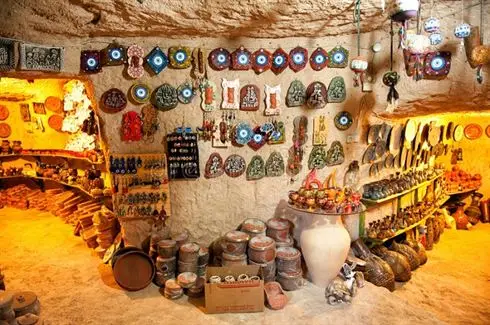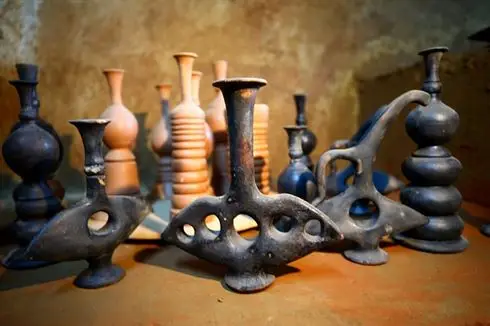An ancient craft with a long history in Cappadocia is Avanos ceramics. These pots may be seen everywhere when you take Cappadocia tours and travel to the area. In-depth explanations of the pottery’s history are provided during guided visits. For the people of Cappadocia, Avanos pottery is crucial.
Information about Avanos
Avanos, together with Ürgüp and Göreme, is a significant tourist destination in Cappadocia. In the region of Cappadocia, Avanos, pottery is quite significant. When people think of Cappadocia, the first thing that comes to mind is fairy chimneys. The pottery produced in Cappadocia is renowned as well. It is also well known for its immense rivers, valleys, and underground cities. Garden pottery is another well-known occurrence.
Everyone is familiar with pottery. Everyone ate something from their casserole and drank water from their pitcher with these pots. There is a sizable Cappadocian ceramic workshop in the Avanos district. Even Seyrani, a folk poet who wrote between 1800 and 1866, observed that blind people are aware of the route to Avanos based on pottery shards. In the past, pottery used to be put on horses and donkeys and sold. Thrown to the side of the road was the pottery that had shattered during the trip. On the sides of the roadways in Avanos, broken pottery gathered and created a line. There is where we get this word.
Avanos is located in Cappadocia, which is well-known for its ceramics.

The history of the territory of Avanos is quite old. Avanos has a long history that begins with the Hittites. Since the time of the Hittites, pottery has been made in the area once known as Venessa. Horses and donkeys once transported pottery from Avanos to nearby cities for sale. Even during the Republican eras, this approach persisted during the Ottoman eras.
The Cappadocian population currently hosts the majority of tourists in the Avanos region. Due to its lengthy history, there are many interesting spots to see and take in. In Avanos, there is Kizilirmak. This area should be chosen for wildlife excursions.
Most people know the Avanos region for its pottery. Here, various and distinctive pottery is made. The forefathers produced pottery on wheels. It is a craft that has been handed down from grandfather to father and father to child for many years. Throughout the areas it has traversed for generations, the Kizilirmak leaves its crimson soil behind. The use of this red dirt in art and
Cappadocia’s Avanos ceramics were shown. Red earth and spindle are combined to create a ceramic paste, and it is with this paste that pottery artists display their artistic talent. These handmade pots are very expensive. Our forefathers have been manufacturing pottery for many years, and they have passed it down to us. For the inhabitants of Avanos, this art has historically been a major source of income. The custom of refusing to give females to men who could not produce pottery was still practiced in the area.
Their crimson color is their most noticeable attribute at first glance. The pots are made with ceramic paste, which is created by combining red dirt and spindles. Wheels are used to create pottery.
How is Avanos pottery made?
When carried out by professionals, making Nevşehir pottery can seem very simple. While observing the masters who use the wheels to produce their craft, this task may appear to be extremely simple. In reality, the endeavor is more difficult than it appears. Avanos pots are distinctive in that they call for both dexterity and imagination. This is why it is also known as Avanos art. Making pottery in a short amount of time is impossible.
The ceramic clay needs to be made, formed, armored, dried, fired, and glazed before anything else. It takes work and is rather lengthy. The features of Avanos ceramics are incredibly varied.

The Kizilirmak beds include oily, soft clay soil that flows from the Avanos Mountains’ flanks. After being sieved, clay soil is combined with water. After that, the soil that turns into clay can be used to create pottery. The clay needs to be stored for a week before it is ready. Each type of Avanos pottery from Cappadocia has its distinct qualities. As a result, different clay qualities may exist. According to the pots that will be manufactured, clay is prepared.
Clay Sculpting
The clay is shaped using a variety of techniques. The type of pottery that is wanted is another factor that influences these techniques. When mass manufacturing is necessary, it can be formed using wheel-like machinery or by employing plaster of Paris molds.
The expert also suggests that you can shape wheels with your hands so that you can accelerate with your feet. The master first shapes the clay by applying pressure with his hands. It uses metal components in the final stage to turn the clay into pots.
Armoring and polishing of pottery
It’s called armoring, painting, and decorating the Avanos pottery after it’s been made but before it’s dried. The pots are stored for two days after armoring to attain a consistency known as leather hardness. Buffering is the process of polishing the surface while the clay is still wet. After going through these procedures, the pots are prepared for drying.
Drying of the Pot
After the pots are polished and armored, and the water is taken out, they are left in the sun for 20 minutes. At this point, if there is no sun, they are held in the “cheeks,” which are workshop spaces, for a day before moving on to the cooking process.
Order of Cooking
The pots must be burned and glazed before they are suitable for use. A sizable tub is used to cook the dried goods at specific temperatures.

It is advised that visitors to Cappadocia produce pottery in Avanos. On excursions to Avanos, visitors can observe how the master potters shape their creations. In the local workshops, ceramic making is an activity you may partake in. The ceramic clay can be molded on the wheels under the masters’ instruction.
Therapists advise a lot of people to do it because it is healthy for the soul. Molding clay is a creative way to express yourself. Prices for creating Cappadocian pottery might differ from one workshop to another. You can create your pots in the Avanos region by rolling them into the desired shape.